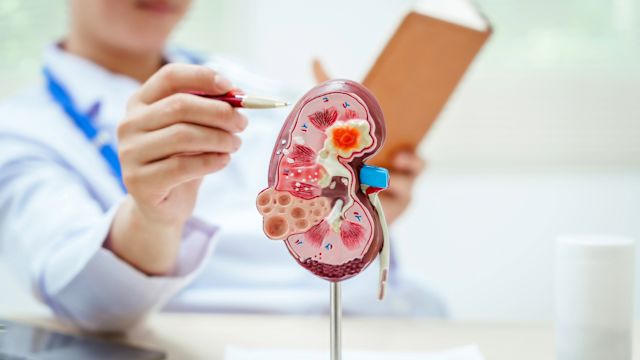Updated on May 15, 2025
The kidneys are a pair of organs located in the lower back, above the hips and below the bottom ribs. Each is about the size of a small fist. These organs are sometimes described as the body's filters, because their main function is to remove waste and excess fluid from the blood.
Complement 3 glomerulopathy (C3G) is a rare disorder that causes damage to the kidneys. There are two types, dense deposit disease (DDD) and C3 glomerulonephritis (C3GN). If you or a loved one has been diagnosed with C3G, the below is a guide to how the kidneys work and what happens inside the kidneys when a person has C3G.
Understanding your kidneys
Blood enters the kidneys through a large blood vessel called the renal artery. As blood moves through the kidneys, it moves through filtering units called nephrons.
- Each kidney contains approximately 1 million nephrons.
- Each nephron has two main parts, the glomerulus and the tubule.
- The glomerulus is a network of small blood vessels. These blood vessels filter out fluid, waste, and other substances as blood moves through the kidney. The plural of glomerulus is glomeruli.
- Fluid and substances that are removed from the blood enter a small tube called the tubule. The tubule acts as a kind of intersection for fluid and other substances that are filtered out of the kidneys. Some fluid and substances are absorbed back into the blood. Excess fluid and waste become urine and travel to the bladder, where they are expelled in urine.
How C3G damages the kidneys
C3G occurs because of problems with a part of the immune system called the complement system. The complement system activates proteins that help the body heal injuries and fight infections.
When a person has C3G, there is abnormal activity in the complement system. This causes the breakdown of proteins called C3 proteins. As these proteins break apart, the pieces clump together. Some of these clumps end up in the kidneys and clog glomeruli. This triggers an inflammatory response by the immune system. Inflammation results in damage to the kidneys. Over time, a kidney will have fewer functioning glomeruli and will be less effective at filtering the blood.
What happens when C3G damages the kidneys
The kidneys allow the body to maintain a balance of fluids, salts, minerals, proteins, and many other substances that it needs to function normally and remain healthy. When damage caused by C3G causes the kidneys to lose function, problems occur.
Symptoms of C3G:
- Blood in the urine. Called hematuria, urine can look pink, red, or brown. This is caused by glomeruli leaking red blood cells into the urine. Urine may also look cloudy due to white blood cells leaking into the urine.
- Proteinuria (protein in the urine). Urine may look foamy, dark, or cloudy.
- Edema, or fluid buildup in body tissues. This can cause swelling around the hands, feet, and ankles, and puffiness around the eyes.
- High blood pressure. More fluid can remain in the blood, causing an increase in blood pressure. This can cause damage to the blood vessels, including the heart. It will also worsen damage to the kidneys.
- Gout. Joint pain caused by a buildup of uric acid (a metabolic waste product) in the body.
A person may also experience fatigue, decreased alertness, and reduced urine output. Over time, C3G can lead to serious complications, including kidney failure, also called end-stage renal failure. At this stage, dialysis or a kidney transplant is needed in order to keep a person alive. Kidney failure affects over half of children and adults with C3G within 10 years of diagnosis.
Treatment for C3G
There is no cure for C3G, but treatment can help slow the disease's progression and reduce symptoms. A treatment plan for C3G may include:
- Medications to control blood pressure and reduce protein in the urine.
- Medications that reduce activity in the complement system.
- Medications to reduce and control edema and other symptoms.
- Changes to diet, such as limiting salt intake, protein intake, and monitoring fluid intake.
- Regular monitoring of kidney function. This will include urine tests and blood tests, such as tests that check for proteinuria.
Treatment plans are individualized and depend on the severity of the disease, the type of C3G, and other factors. A healthcare provider will be your best source of information about treatment options.



